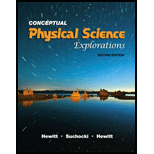
The importance of balancing a chemical equation.
Answer to Problem 3RQ
To ensure the number of reacting particles and the number of product particles is same and to conserve the mass on both the sides of the chemical equation.
Explanation of Solution
The expression used to express a chemical process taking place in a
Since atoms cannot be created in a chemical reaction or either cannot be destroyed during a chemical process. Thus, a chemical equation should be balanced.
Balancing is the technique to check whether the number of reactant atoms and the number of product atoms involved is same in the chemical process to ensure the Law of conservation of mass.
Conclusion:
Therefore, to ensure the number of reacting particles and the number of product particles are the same and to conserve the mass on both the sides of the chemical equation.
Chapter 20 Solutions
Conceptual Physical Science Explorations
Additional Science Textbook Solutions
Conceptual Integrated Science
Physics: Principles with Applications
University Physics with Modern Physics (14th Edition)
Introduction to Electrodynamics
Life in the Universe (4th Edition)
Essential University Physics: Volume 1 (3rd Edition)
 College PhysicsPhysicsISBN:9781305952300Author:Raymond A. Serway, Chris VuillePublisher:Cengage Learning
College PhysicsPhysicsISBN:9781305952300Author:Raymond A. Serway, Chris VuillePublisher:Cengage Learning University Physics (14th Edition)PhysicsISBN:9780133969290Author:Hugh D. Young, Roger A. FreedmanPublisher:PEARSON
University Physics (14th Edition)PhysicsISBN:9780133969290Author:Hugh D. Young, Roger A. FreedmanPublisher:PEARSON Introduction To Quantum MechanicsPhysicsISBN:9781107189638Author:Griffiths, David J., Schroeter, Darrell F.Publisher:Cambridge University Press
Introduction To Quantum MechanicsPhysicsISBN:9781107189638Author:Griffiths, David J., Schroeter, Darrell F.Publisher:Cambridge University Press Physics for Scientists and EngineersPhysicsISBN:9781337553278Author:Raymond A. Serway, John W. JewettPublisher:Cengage Learning
Physics for Scientists and EngineersPhysicsISBN:9781337553278Author:Raymond A. Serway, John W. JewettPublisher:Cengage Learning Lecture- Tutorials for Introductory AstronomyPhysicsISBN:9780321820464Author:Edward E. Prather, Tim P. Slater, Jeff P. Adams, Gina BrissendenPublisher:Addison-Wesley
Lecture- Tutorials for Introductory AstronomyPhysicsISBN:9780321820464Author:Edward E. Prather, Tim P. Slater, Jeff P. Adams, Gina BrissendenPublisher:Addison-Wesley College Physics: A Strategic Approach (4th Editio...PhysicsISBN:9780134609034Author:Randall D. Knight (Professor Emeritus), Brian Jones, Stuart FieldPublisher:PEARSON
College Physics: A Strategic Approach (4th Editio...PhysicsISBN:9780134609034Author:Randall D. Knight (Professor Emeritus), Brian Jones, Stuart FieldPublisher:PEARSON





